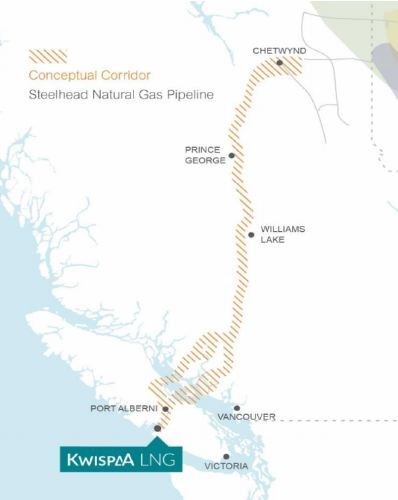Vancouver-based energy company Steelhead LNG says they are in the early stages of investigating a pipeline route from Chetwynd area to their planned Kwispaa LNG facility on Vancouver Island.
The planned Kwispaa LNG facility - a separate project from the pipeline that will be regulated separately - is co-managed by Steelhead LNG and Huu-ay-aht First Nations. In October 2018, they submitted a project description to initiate the British Columbia Environmental Assessment Office process.
The proposed route for the pipeline begins in the Chetwynd area, parallels existing multi-utility corridors near Williams Lake, branches off towards south coast, with options through the Coast Mountains, and with a subsea crossing to Vancouver Island to end at Kwispaa LNG, which is on the west coast of the island.
"We understand the importance of engaging communities at the earliest stage in the route exploration," says Corey Goulet, vice president, pipelines.
"We're committed to building mutually beneficial relationships with communities, and developing projects in an environmentally responsible manner."
It will include about 1,000 km of 48-inch diameter pipeline, and is slated to transport approximately two billion cubic feet per day in its first phase, expandable to approximately four bcf/d at full build-out. The project also plans to include metering facilities, and two compressor stations at the initial phase, with three or more additional stations constructed and operated at full build-out.
One of the initial compressor stations will be located where the pipeline starts, near Chetwynd. Steelhead says their team is looking at the option of electrifying some of the compressor stations.
In an anticipated timeline, Steelhead LNG plans to select a preferred route corridor and enter the British Columbia EAO in the first quarter of this year, before submitting environmental assessment applications for both projects, and a final investment decision in 2020. The construction phase would take approximately four years - 2024 would see both projects functional.
At the January 10 Peace River Regional District board meeting in Dawson Creek, delegates from the company presented to the board.
Board directors noted concerns with the cumulative impacts of the various projects in the region.
"The people living on the land there are impacted severely, and the private landowners are starting to feel like their land isn't worth anything, other than for extraction of natural resources," said Area D director Leonard Hiebert.
"Each and every landowner that will be touched, would have an individual relationship or discussion with us as well," said Goulet. "We have a plan to spend time with each and every person affected by the project, and provide them with the information and the opportunity for input."
Goulet also noted that not all production of gas for the pipeline may be new, but rather a chance for existing production to go west, instead of east through Alberta.
"All of the gas may not be incrementally new gas, some of it may be existing production that is just going to a different market that has a higher netback. That's actually one of the biggest advantages that gas suppliers we're talking to see in a pipeline like this -- to increase what they can get for their gas."
Area E director Dan Rose noted that he felt the timeline presented by Steelhead LNG "is really optimistic."



